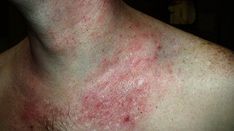Background
Vesicular palmoplantar eczema is a term used to describe a group of diseases characterized by a pruritic vesiculobullous eruption involving mainly the hands and feet. Clinical presentations vary from acute dermatitis to more chronic relapsing and remitting disease patterns. The diversity of presentation has created challenges in classifying hand eczema. A 2011 publication assembled an algorithm for chronic hand eczema based on etiology, morphology and clinical features. [1]
Although considerable overlap exists in the various forms of vesicular palmoplantar eczema, the disease can be roughly divided into four distinct categories: pompholyx, subacute or chronic relapsing vesiculosquamous eczema, chronic vesiculohyperkeratotic or hyperkeratotic eczema, and Id reactions. [2]
Pompholyx ("blister" or "bubble" in Greek) may be further subdivided into vesicular and bullous forms, in which patients present with acute severe eruptions of blisters over their palms and, less commonly, the soles.
Chronic vesiculosquamous eczema, also called dyshidrotic eczema, was initially thought to be caused by abnormal functioning of the sweat glands. This association has since been disproved, but the term dyshidrotic eczema is still used. Patients with this variant present with small (1-2 mm) vesicles on nonerythematous skin involving the inner sides of the fingers or on the palms and soles. The vesicles are pruritic, last 1-2 weeks, desquamate, and then recur at unpredictable intervals. [2]
The chronic hyperkeratotic variety involves mainly the central palms, where it causes thickening and fissures. This category is notoriously the most difficult to treat. [2]
An id reaction refers to a widespread eczematous eruption in response to a distal focus of infection. Common manifestations include a papulovesicular eruption with vesicles on the hands and feet secondary to a fungal infection (dermatophytid). [2]
Despite the wide range of clinical presentations, all four types of vesicular palmoplantar eczema are histologically characterized by features of dermatitis, such as spongiosis and exocytosis.
Pathophysiology
Vesicular palmoplantar eczema is often thought to have an unidentified intrinsic cause. Although many etiologic factors are described, the underlying pathology of vesicular palmoplantar eczema is unknown. One study examined the roles of aquaporin 3 and aquaporin 10, which are water/glycerol channel proteins located in the epidermis, and concluded that overexpression of these channels may play a role. [3]
Similarly, although certain triggers have been associated with the development or worsening of symptoms such as atopy, contact allergy, and psychological stress, how these triggers cause flares has not been elucidated. [2]
Vesicular palmoplantar eczema results in histologic evidence of dermatitis, such as spongiosis, which is often accompanied by lymphocytic infiltrates.
Etiology of Palmoplantar Eczema
The etiology of hand eczema is unknown, but most observers suggest that intrinsic changes in the skin are responsible for vesicular palmoplantar eczema. A 2012 study of an autosomal dominant form of pompholyx found a genetic linkage on chromosome 18. [4] Whether other forms have a similar genetic linkage is not clear. However, several exogenous factors have been implicated in the causation or worsening of vesicular palmoplantar eczema. [5]
Coexisting atopy is common in patients with palmoplantar eczema. A study found a strong association between pompholyx and atopic status. [6] However, this is by no means the only causal relationship because many patients have no history of atopy. In a univariate analysis, personal and family history of atopy, history of eczema, hyperhidrosis, and tinea pedis were the main factors associated with pompholyx cases. [7]
Emotional stress may also trigger episodes.
Seasonal changes seem to be directly related to relapses, as episodes are most common in the spring and summer months. Warm weather has been known to initiate episodes, with several cases reporting photo-induced pompholyx. Although dysfunction of the sweat glands is no longer accepted as the cause of dyshidrotic eczema, increased sweating seems to exacerbate the condition and many patients with palmar hyperhidrosis also have coexisting dyshidrotic eczema. Hyperhidrosis can be an aggravating factor in up to 40% of patients with pompholyx eczema. [8] Photosensitivity to ultraviolet A (UVA) has been reported as an etiologic factor in a small subset of patients with eczema. [9] Therefore, worsening of the disease in summer months may be due to the increase in exposure to sunlight. Conversely, UVA therapy is a widely accepted form of treatment for palmoplantar eczema. [10]
Sensitivity to certain metals, particularly nickel and cobalt, has been linked to vesicular palmoplantar eczema. Low zinc levels have been proposed to play a role. A 2016 prospective case-noncase study examining serum levels of cadmium and zinc noted a significant decrease in zinc levels in patients with vesicular palmoplantar eczema compared with the noncase group. The exact role of zinc in the pathogenesis of vesicular palmoplantar eczema remains unknown but may be related to the impact of deficient states on inflammation. [11]
Exogenous factors causing allergic contact pompholyx include balsams and cosmetic and hygiene products. [12]
A 2013 study showed an increase in IgE levels and vesicular palmar eczema after house dust mite exposure. [13]
Drugs responsible for inducing episodes include oral contraceptive pills and aspirin. Palmoplantar eczema occurring after intravenous immunoglobulin (IVIG) therapy is reported. [14] Case reports have described palmoplantar pompholyx secondary to secukinumab therapy for psoriasis. [15, 16]
A review of eczematous reactions linked with intravenous immunoglobulin (IVIG) therapy cited pompholyx as occurring in 63.5% of the cases reported having an eczematous reaction. [10] While most cases are seen in adults, [17] there have been occurrences in the pediatric population after IVIG administration for Kawasaki syndrome. [18] The onset of palmoplantar eczema typically occurs within a few days of the first treatment and can reoccur when rechallenged. The mechanism of pompholyx induction is unknown but may be related to the dose, infusion rate, type of IVIG, and even possibly the underlying disease being treated. [19] The majority of IVIG-associated cases of vesicular eczema are observed in patients with neurologic disorders, including multiple sclerosis, Guillen-Barre syndrome, amyotrophic lateral sclerosis, motor neuron disease, and chronic inflammatory demyelinating polyradiculoneuropathy. [18]
Fungal infections, particularly tinea pedis caused by Trichophyton rubrum, are most commonly implicated in id reactions. Bacterial infections play a role in both causation and in secondarily infecting lesions.
Cigarette smoking has been suggested as a pathogenetic factor in palmar eczema [20, 21] and may also reduce the efficacy of topical therapy with psoralen and UVA (PUVA). [22]
HIV infection has been associated with pompholyx, with response to antiretroviral therapy; conversely, one case report describes of 2 HIV-positive patients who developed severe dyshidrotic eczema after starting antiretroviral treatment, thought to be due to an immune reconstitution inflammatory syndrome. [23, 24]
Epidemiology
Frequency
United States
The frequency of vesicular palmoplantar eczema in the United States is unknown.
International
The true incidence is unknown, but vesicular palmoplantar eczema is probably responsible for 5-20% of all cases of eczema of the hand. The dyshidrotic pattern is most common [25] ; a 2012 study found pompholyx accounted for 14% of all cases of hand eczema. [6]
Sex
The male-to-female ratio for vesicular palmoplantar eczema is 1:1.
Age
Pompholyx most commonly occurs in patients aged 20-40 years, but it may occur in individuals of any age. Onset in patients younger than 10 years is unusual. The frequency of recurrent episodes of pompholyx decreases after middle age, although this is not true of chronic vesicular and hyperkeratotic variants.
Prognosis
Patients with mild cases of palmoplantar eczema have an excellent prognosis. The more severe chronic hyperkeratotic variety of vesicular palmoplantar eczema (eczema tyloticum) often requires lifelong treatment and results in considerable disability.
Acute vesicular eczema (pompholyx) in both major and minor forms tends to occur intermittently or sporadically and becomes less common as patients age. Episodes are less frequent from middle age onward. [2]
The prognosis is less satisfactory for subacute and chronic forms of vesicular and hyperkeratotic eczema, which often persist for years, than for other forms.
Patient Education
For patient education resources, visit the Skin Conditions and Beauty Center. Also, see the patient education article Eczema.
-
Pompholyx of the palms.










